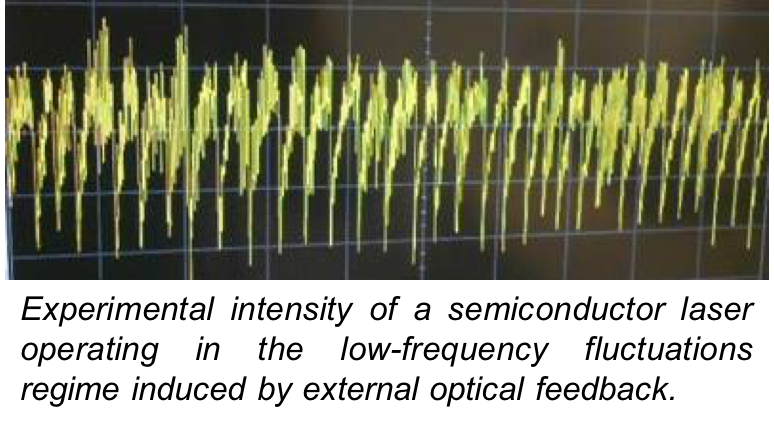Nonlinear dynamics of semiconductor lasers

Semiconductor lasers (or laser diodes) are important practical devices, widely used in optical communications, optical signal processing, and life science applications (imaging, sensors, etc.). While “solitary” diode lasers emit a stable output, under external perturbations these lasers display a wide range of dynamical behaviors that can be exploited for applications.
The research in the Semiconductor Laser Laboratory is focused in the influence of optical feedback and/or optical injection. We study the regime of low-frequency fluctuations, in which the laser intensity exhibits abrupt and apparently random dropouts that resemble neuronal spikes (see Fig.). We refer to these dropouts as optical spikes.
We are interested in exploring the similarity of optical spikes and the spikes of biological neurons. Establishing a connection between these different dynamical systems can offer new perspectives in both, photonics and neuroscience. Laser-based photonic neurons can provide a novel, inexpensive and controllable experimental set up for improving our understanding of neuronal activity. On the other hand, laser-based photonic neurons can be the building blocks of neuro-inspired, ultra-fast optical computing devices.
We are also interested in extreme optical pulses (known as optical rogue waves) induced by optical feedback or injection. Our work is aimed at understanding the mechanisms that trigger them and finding ways to control and predict them.
Another research topic is the possibility of using optical chaos (generated by optical feedback or injection) for the development of an incoherent light source specifically designed for reducing or mitigating speckle in retina double-pass imaging instruments.
Involved Researchers: C. Masoller, M. C. Torrent, J. Tiana-Alsina.
PhD Students: C. Quintero, D. Halpaap
Associated projects
Complex physical and biophysical systems: towards a comprehensive view of their dynamics and fluctuations (ComPhysBio). This coordinated project (which involves three research teams at UPF, UB and UPC) studies nonlinear and stochastic phenomena in a broad class of systems including information processing by optical networks, extreme events in complex systems, neuronal excitability and brain dynamics, among many others.
Scientific coordinator: Masoller, C.
Funding Agency: Ministerio de Economía y Competitividad
Participants: Ramirez de La Piscina, L.; Torrent, M.C.; Peñaranda, A.; Pigolotti, S.; Pons, A. J.; Cencini, M.; Meca, E.
Project No: FIS2015-66503-C3-2-P.
Start/Ends dates: 01/01/2016 - 31/12/2018.

ICREA Academia. The aim of this project is (i) to exploit nonlinear dynamics and stochastic phenomena for novel applications and (ii) to develop advanced data analysis tools for studying the output signals of complex systems. A specific research objective is aimed at exploiting the optical spikes emitted by a semiconductor laser with optical feedback or injection, for implementing photonic neurons that mimic biological ones, but operate in times scales that are several orders of magnitude faster.
Scientific coordinator: Masoller, C.
Funding Agency: Institució Catalana de Recerca i Estudis Avançats.
Project No: ICREA ACADEMIA 2015-04.
Start/Ends dates: 01/01/2016 - 31/12/2020

BE-OPTICAL: Advanced biomedical imaging and data analysis. BE-OPTICAL is a European training network that provides a structured training program to 14 PhD students in a wide range of optical imaging technologies and signal processing tools. Two PhD students in the DONLL group are working in (i) the development of incoherent light sources for speckle reduction in ocular imaging and (ii) the development of novel tools for the characterization and classification of biomedical images, with focus on ocular images. beoptical.eu.
Scientific coordinator: C. Masoller
Funding Agency: Commission of European Communities. H2020.
Partners: Georg-August-Universitaet Göttingen Stiftung; Uniwersytet Mikolja Kopernika W Toruniu; Max Planck Gesellschaft zur Foerderung der Wissenschaften; Institut de Microcirurgia ocular dos; PicoQuant Innovations GMBH; University of Saint Andrews; University of Glasgow; Centre National de la Recherche Scientifique; UPC
Project ref. No.:H2020-675512
Start/Ends dates: 1/12/2011-30/11/2015.
Share: